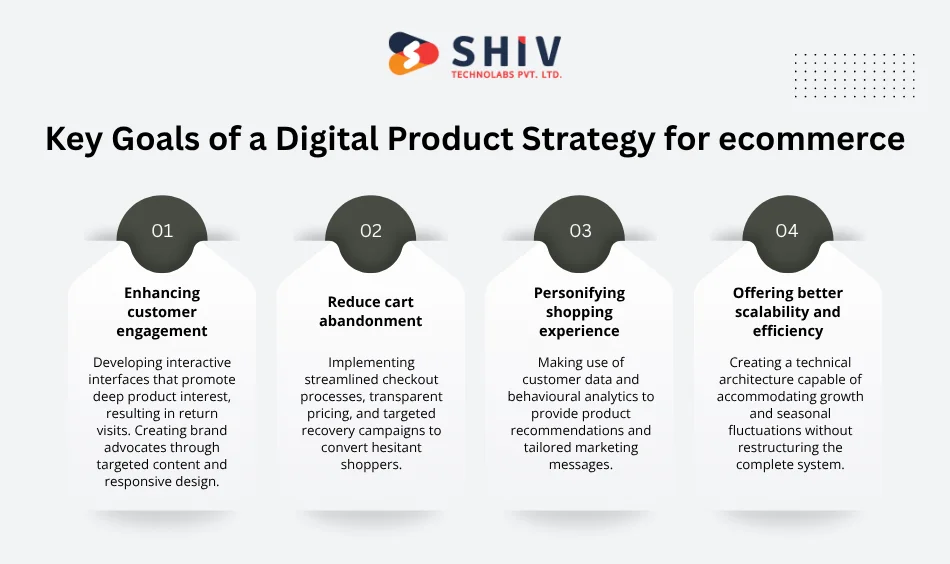Table of Contents
E-commerce is getting more complex day by day, underlining the need for companies to distinguish themselves on one hand, and meet those expectations that are evolving at quite a fast rate on the other. To grow your business and outdo your competitors, you should do more than just have an excellent e-commerce website – it means having a digital products strategy which considers your business objectives as well as customers’ needs.
A tailored ecommerce product strategy is the foundation for sustainable growth, which connects all touchpoints from the initial discovery to post-purchase engagement. When businesses join hands with an expert product development company, they get specialized expertise that converts abstract business goals into concrete digital solutions.
When working with an ecommerce product development service, you receive the strategic guidance that is required for designing, building, and further developing custom digital solutions. In this article, you will find out what makes digital product strategies vital in today’s business environment, how custom initiatives boost measurable growth, and the practical approach to designing ecommerce digital products that offer long-term benefits.
What Makes Digital Product Strategies Crucial for Ecommerce Businesses?
An ecommerce digital product strategy is like a manual that guides the process of how online businesses create, develop, and optimize their digital offerings. This framework is not just limited to website design – it covers everything, right from customer interactions, backend systems, to technology that powers modern online commerce.
While the importance of digital product strategy in ecommerce is not immediately clear, with its analysis, it is evident how it connects three crucial pillars – marketing, technology, and customer experience. An effective product strategy for online stores combines these priorities into a unified vision that delivers measurable results.
Companies that go without a strategic plan get disconnected systems, inconsistent brand messaging, and fragmented customer data. There is low coordination of activities, which results in low conversion rates, high cart abandonment, poor retention, and wasted marketing spend. The move towards ecommerce digital transformation presupposes a strategy that is both about the immediate needs and the future scalability.
Key Goals of a Digital Product Strategy for ecommerce

- Enhancing customer engagement: Developing interactive interfaces that promote deep product interest, resulting in return visits. Creating brand advocates through targeted content and responsive design.
- Reduce cart abandonment: Implementing streamlined checkout processes, transparent pricing, and targeted recovery campaigns to convert hesitant shoppers.
- Personifying shopping experience: Making use of customer data and behavioural analytics to provide product recommendations and tailored marketing messages.
- Offering better scalability and efficiency: Creating a technical architecture capable of accommodating growth and seasonal fluctuations without restructuring the complete system.
How Does a Tailored Digital Product Strategy Drive Growth?
Generic template-based approaches may seem to be ready for deployment, but they limit differentiation. It should be noted that every business operates within unique market conditions and thus different customers should be given distinct brand values.
If digital product development experts create strategies that are customized, they do so by first learning the habits of the target audience, their pain points, and purchasing patterns. This approach, based on research, guarantees that each design choice and technology selection will be in direct support of business objectives.
A custom ecommerce product strategy is one that integrates brand identity seamlessly across all the touchpoints, thereby creating experiences that are coherent and which people can quickly recognize and trust.
| Aspect | Generic Strategy | Tailored Strategy |
|---|---|---|
| Customer Focus | Broad & basic assumptions about user needs | Based on specific user behavior & detailed analytics |
| Scalability | Limited by platform constraints | Adaptive & future-ready architecture |
| Integration | Predefined tools with restricted flexibility | Flexible tech stack integration across systems |
| ROI Impact | Moderate short-term gains | Measurable long-term ROI with compounding benefits |
When you undertake ecommerce product development services from a reliable product development company, they ensure that user experience design, analytics implementation, and backend system engineering are in sync. Digital product development experts bring cross-functional skills that act as a bridge between business strategies and technical executions, resulting in future-evolution-oriented products.
What Are the Steps to Build a Digital Product Strategy for Ecommerce?
To know how to build a digital product strategy for ecommerce, you should understand that strategic planning is an ongoing cycle of developing, implementing and optimizing processes. Successful ecommerce digital transformation is built upon the collaboration between business stakeholders, developers and designers as well as consumer facing teams.
A product development company for ecommerce brings everyone into a single vision and makes the decision-making process transparent. The sequence of actions to formulate e-commerce digital products is on a controlled yet flexible framework.
Steps to Plan Ecommerce Digital Products Effectively:
- Conduct detailed market and customer research: Analyze what competitors are offering, find the market gap, and make detailed buyer personas that guide decisions on features and positioning.
- Clarify determined business goals and KPIs: It is recommended to have a clear target in mind concerning the aspects of revenue growth, customer acquisition, return rate, and other metrics that align with overall business objectives.
- Chart user flow and find product shortcomings: Create a description of what the consumers go through before arriving at the decision to buy, and then identify areas of inconvenience and low points to enhance products.
- Choose the appropriate technology stack: Evaluate platforms and tools according to scalability requirements, integration needs, long term considerations of maintenance etc.
- Build prototypes and validate ideas: Make interactive prototypes that will give you an opportunity to get feedback from stakeholders as well as test users on the proposed solutions before spending any considerable amount on resource development.
- Develop, test and refine the product: Implement features using agile methodologies that give priority to iterative releases and continuous testing system.
- Measure performance and iterate through the data: Start by fully implementing analytics for tracking user behaviours and business metrics; then use these insights to further develop prioritized improvements.
For example, an AI-powered sizing tool can be included in the product roadmap of an ecommerce fashion brand that discovers through research that 40% of returns are caused by the size uncertainty issue. Support obtained from e-commerce product development service providers along this way makes certain every step gets proper attention and expertise.
How a Strategic Partner Shapes Successful ecommerce Product Development

Partnering with a seasoned product development company goes a long way in connecting the dots between what your business wants to achieve and its technical implementation. Your internal teams know your business context, but when you hire specialized ecommerce product development services, you get to use their tried and tested methodologies, cross-industry insights and deep technical knowledge that enhance development efforts while minimizing risks.
At the rate which digital products are growing, it is clear that those who specialize in ecommerce digital transformation have deep understanding of scalability considerations, as well as possible difficulties that can arise during implementation. This kind of knowledge is very important when a company has to make a decision about what technology solution, or even architectural design, will affect its operations for years.
Qualities of the Right Product Development Partner
- Proven ecommerce experience: Existing case studies and past record of successfully creating online stores, marketplaces or subscription platforms.
- UX/UI design capability: Portfolio of user interface designs that are intuitive, conversion-centred and are grounded on user research methods and testing frameworks.
- Post-launch support and iteration: Clear plans for ongoing maintenance, performance monitoring or feature enhancement.
- Effective communication: Regular updates, transparent assessment of challenges, and approachable team members who can quickly address concerns.
Partnering with an experienced product development services provider can help integrate the platforms with more advanced analytics solutions, marketing automation tools, and scalable cloud infrastructures that are scalable. The right product development company brings a strategic point of view, which helps businesses to make intelligent judgments, create technological solutions/products, and leverage existing platforms.
Common Challenges ecommerce Businesses Face Without a Clear Product Strategy
There is a possibility that by not having an ecommerce product strategy, you may face predictable problems that might grow over a period of time. These challenges tend to grow rather slowly, so it is quite obvious to write them off as temporary glitches.
Companies that do not have clear product roadmaps are at risk of having inconsistent branding across customer touchpoints. The result is confusion among customers and dilution in brand identity. Newly incorporated features in a haphazard manner can disrupt user experience and provoke prospective customers to turn to your competitors.
The importance of digital product strategy in ecommerce becomes more obvious when businesses find out that their self-assembled technology stacks do not have enough capacity to support growth initiatives. Legacy systems built without strategic planning lack sufficient integration, leaving teams with manual transfer of data or abandoning valuable features.
Companies that do not have a strategic direction spend a lot of resources on fixing disconnected systems and managing technical debt. Also, the incoherence of an online store’s product strategy hinders data-driven decision-making, which in turn prevents personalization and targeted marketing.
Major Risks of Operating Without a Defined Strategy
- Absence of a clear product roadmap: Teams are engaged in pursuing scattered initiatives than building coherent long-term objectives or sustainable competitive advantages.
- Fragmented customer data: Information about customers, which is fragmented across the systems hampers conducting a thorough analysis based on personalization efforts, and performance measurement.
- Missed opportunities in automation: Manual processes exist because there is no strategic framework for identifying and prioritizing the processes that can be automated.
- Inability to scale operations: Technical limitations prevent businesses to tap on growth opportunities or even handle seasonal demand spikes without having to replace the entire system.
Real Examples of ecommerce Businesses That Benefited from Tailored Digital Strategies
The essence of the strategic planning value can be concretely demonstrated through a review of the specific approach that businesses have used in tailoring a digital product strategy for ecommerce.
Example 1: Fashion Brand AI Recommendation System – A mid-size online fashion store partnered with an ecommerce product development company based in India for the integration of sizing recommendation technology powered by artificial intelligence. Machine learning algorithms were developed by analyzing historical purchase and return rates data to provide good sizing recommendations for customers of online stores. Within six months of implementing this intelligent sizing solution, the merchant experienced 32% reduction in size-related returns and 28% growth in average order value.
Example 2: Grocery Store Using Personalized App Notifications – A regional grocery chain partnered with a product development company to provide a comprehensive mobile app that had personalized shopping lists and timely notifications about product availability. The tailored product strategy resulted in a growth of monthly ordering frequency by 45% among app users, while customer lifetime value increased by 67% within the first year.
Example 3: Fitness Ecommerce with Subscription-Based Model – A specialty fitness equipment retailer developed a new approach that combined equipment sales with workout subscriptions. The integrated platform generated 40% of recurring revenue within 18 months as well as reducing customer acquisition costs by about 55%.
Conclusion
The competitive intensity of present-day ecommerce makes it imperative for businesses to go beyond basic digital presence toward strategic product development, which aims at differentiating their offerings and creating loyal customer relationships. A tailored digital product strategy for ecommerce acts as the foundation for sustainable growth, operational efficiency, as well as customer retention.
A successful ecommerce product strategy can be achieved only when you can read and understand your unique market position, customer needs, and business, and translate those insights into coherent product roadmaps. In the ecommerce domain, digital product strategies play important roles other than just immediate tactical advantages. They create organizational alignment and place businesses in a good position to adapt rapidly as markets develop.
By partnering with an experienced product development company like Shiv Technolabs, companies can improve productivity and efficiency. Partnerships like these will allows quick time-to-market, and reduce potential implementation risks. If you want to give your online store a new look with expert advice on ecommerce product development, get in touch with our product development services team today.
FAQs
What is a digital product strategy for ecommerce?
A digital product strategy establishes the design, technology, and business objectives alignment to provide unified ecommerce experiences which will deliver the best ROI.
How to plan a product strategy for an online store?
Begin with market research, define KPIs, map user journeys, choose technology stack, develop prototypes, and deploy analytics for continuous improvement.
Why is customization important in ecommerce product development?
Major contrast between businesses is created by customizing their solutions to be more personalized that drive higher engagement and conversion rates as compared to generic solutions.
What makes a good product development company for ecommerce businesses?
Seek for proven experience in the field, good skills in UX/UI, agile methods, transparent communication and comprehensive post-launch support.
How does digital transformation impact ecommerce growth?
Digital transformation automates workflows, implements advanced analytics, and enables personalization. The result is a reduction in cart abandonment, increase in order values, and improvement of customer retention that results in sustainable growth.






















